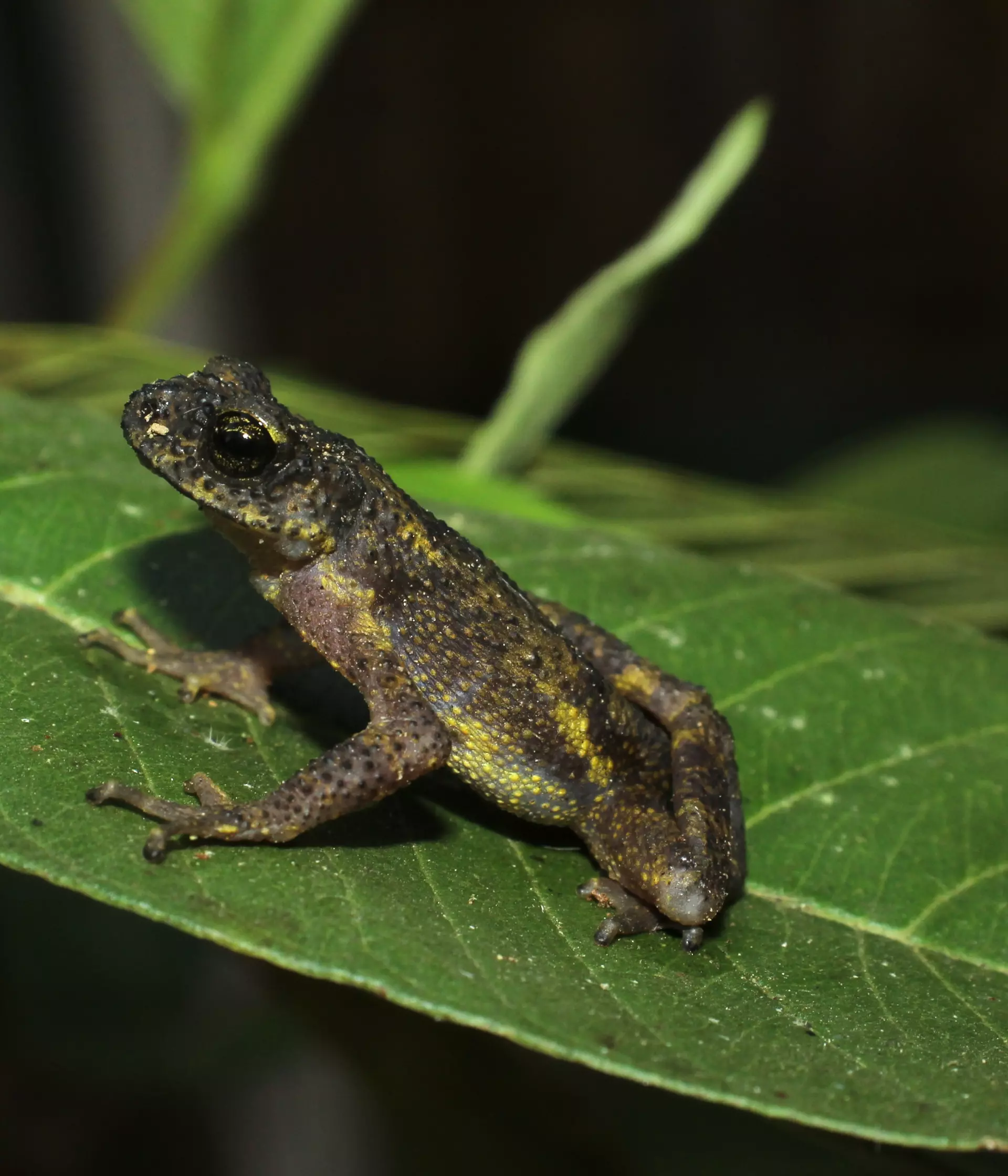EDGE Fellow R.S.Naveen describes the journey of identifying a new Critically Endangered toad species nestled among India’s misty subtropical forests
In the Indian state of Meghalaya, often hailed as the "Abode of the Clouds" due to its misty, enchanting landscapes, resides an elusive, Critically Endangered EDGE species - the Meghalaya rock toad (Bufoides meghalayanus). This unique toad lives inside the crevices of rock boulders in streams winding through leafy forests on the slopes of the Khasi hills.
Despite widely believed to be only found in this region, 2001 saw a report of this species in a number of locations in a mountain range in the neighboring state of Mizoram, approximately 200 km away from the sites in Meghalaya. Eager to understand if this threatened species had a wider range than previously understood, my field assistant Lising Gabil and I embarked on our journey in March, 2023, heading to the Dampa Tiger Reserve in Mizoram to confirm the presence of this species.
Studying Amphibians in India
Despite a week of rigorous searching of likely habitats within the reserve's core areas, our initial efforts did not yield a single rock toad. However, a fortunate twist of fate awaited us during one memorable morning; while having breakfast at a local food shop, a local villager approached us and introduced himself as Mr. Mamuna, an Anti-poaching Watcher at the reserve. Intrigued by our work, he shared photographs of frogs he had seen in the reserve. As we scrolled through these pictures, our excitement surged when we spotted an image of a rock toad. We couldn't contain our joy when we realised that this was the very amphibian we had been tirelessly searching for. I informed him of this, and he immediately agreed to take us to the location where he had photographed the animal, approximately 20 km away by road from our base camp.
We meticulously planned and packed our supplies for a 3-day expedition. The very next day, we hitchhiked on a truck to reach our destination. After an approximately 5-hour journey, we arrived and immediately began our search, we were full of excitement. Sadly, our hopes were dampened when we discovered that recent road construction work from the previous year had polluted the stream where Mamuna had first spotted the toad. Despite two days of relentless searching, our efforts yielded no success.
Disappointed at this turn of events, we returned to our base camp. During the return journey, we came across a small dry stream not far from our original survey site. Intrigued, we decided to explore the area. Within just about 30 minutes of searching, we spotted a rock toad resting inside a rock crevice.
However, upon closer examination, I suspected that this individual was not the Meghalaya rock toad. The shape of the poison glands were different than expected, it had less warts than other rock toads, and there was a striking pattern of striking yellow and black reticulations on its back. I immediately shared pictures of the species with Dr. Benjamin Tapley, ZSL’s Curator of Reptiles and Amphibians, and he shared my thoughts.
How do scientists identify new species?
Eager to confirm this, I photographed this adult, took genetic samples and immediately headed to Aizwal, the State capital of Mizoram where I sent off our samples for analyses. Upon our return to Dampa, we eagerly awaited the results. After three days - which felt like thirty - the results arrived, confirming our suspicions – this, indeed, was a new species.
Over the next few days, guided by Mamuna's local knowledge, we explored several similar, dried-out forest streams scattered across the Dampa Tiger Reserve, relying on a diverse range of transportation methods, including hitchhiking on pick-up trucks and even JCB road rollers.
We encountered five more individuals of this rock toad over the following days and then began the arduous task of formally describing this species – the Mizoram rock toad - as new to science.
Why is species identification important for conservation?
The latest in a series of papers from ZSL’s EDGE of Existence Programme describing a species for the first time, our paper describing this rock toad from Mizoram is of importance because naming it allows for further assessments of its status and for it to be included in conservation legislation.
This is particularly important for the Mizoram toad as the evidence suggests that this species qualifies for being Critically Endangered, just like the nearby Meghalaya rock toad. During our surveys in the Dampa Tiger Reserve, we noted that this species - like other rock toads - is a habitat specialist living only in rocky outcrops in pristine forest habitats. Even though its known habitat is protected by the Indian government as a tiger reserve, we were disheartened to encounter rock mining activities in the buffer areas—a looming threat to this new species.
More importantly, through our identification of the Mizoram rock toad, we confirm that the Meghalaya rock toad is a range-restricted species with its entire known distribution range spanning less than 1 square kilometer. This underscores the urgent need for its conservation through the protection of its habitat. Taking the steps to understand these species and the threats that they face are essential to building a future where they can thrive.
Funders:
This work was generously supported by Stiftung Artenschutz (Species Conservation Foundation).
Climate change and human activity have pushed our precious planet to its limit, causing the devastating loss of so many habitats and species. From lab to field, hands on and behind the scenes, we’re leading the future of conservation, shaping agendas and influencing change to support better life, health and living for people and wildlife.
